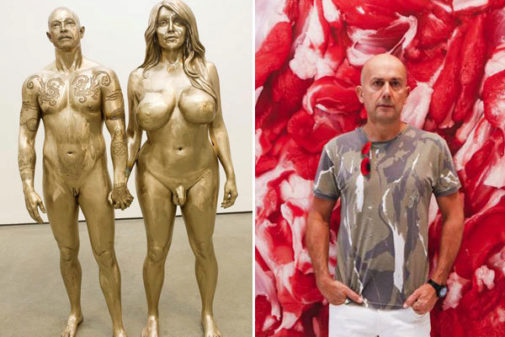Heirs of conceptualism and punk, the Young British Artists decided to kill the former and build on the latter. Gillian Wearing, Tracey Emin or Marc Quinn questioned abstraction and its opposite. In an interview in the recent Hay Festival of Segovia, Marc Queen talks about art and his new project, Our Blood , which will be installed in the New York Public Library: a transparent pavilion in which the stories of 10,000 people will be amplified next to two symmetrical cubes with the blood donated by 5,000 refugees and many other non-refugees .
Is Our blood your most ambitious proposal? On the one hand there is the sculpture, but there is also the video installation with the stories of 10,000 people. Blood cubes represent a common humanity. In the videos we find the individual voices and stories told by real people. My blood, your blood, the blood of a refugee placed on a plate is the same color, there is no difference. A refugee from Chile told me that she was tortured and told her that it was nothing, nobody, and she replied: "My blood and my organs are the same as yours." The interrogators could not answer. How do we value people within society? That is why the video shows well-known people along with other strangers. Our Blood connects with Self , a series of self-portraits made with his own blood in which he has been working since 1991. But now he shifts his own image towards a collective portrait. Yes, Self is in a sense the beginning of this sculpture. My first works are about me and my body, but I started working with the concept of other people: people with disabilities or people who transformed their body, changing sex or tattooing. It was a natural progression. In 2015, when I saw all those images of refugees, I thought it was a theme that defined our time. I want to make art about the time we live in, because for me art is the memory of the world. We remember Guernica for Picasso's painting. I often donate works for auctions that raise a lot of money and that help charities, which is fantastic, but I don't feel that I am part of that cause deeply. I want to see myself involved in the cause in depth. It is said that art, music, poetry saves lives. In some cases they do it indirectly. In this case it is a direct action that affects the lives of specific people. Yes, somehow in my work I have always taken this literally. We say that art changes the world, but does it really? We will try to make a work that really changes it. Art becomes a form of activism, definitely. I believe that today art must commit itself to the world and be an activist, but in a humanitarian way. I don't want to take part politically. What questions should art ask today? Who are we? How do we relate to the world and people? Where do we go? As in Gauguin's painting, where do we come from? About us? Where are we going? These are the questions. I think they haven't changed, and I think there really are no answers. Each generation has raised the same questions differently and that is interesting. When you compare art and science there are similarities, they share certain common areas and interests, but the difference is that science seeks an answer and art asks a question. He usually works on very long projects that extend over time, such as Self . How do you know that a job is finished? I always say that Self is Rembrandt played by Samuel Beckett: fail, fail, but try again, try again, try again ... One of the interesting aspects that Self has is this idea of trying to do something that is life, that is as close as possible to it. Art is not life, but it runs parallel to it in some way. Are you worried about the survival of your own work over time, its deterioration? Some of my works are material, who knows if they will survive, depends on society. And I think that is the reason why I wanted to do this work around refugees with their frozen blood. Electricity, the possibility of maintaining something in a state that is not its natural state, is the sign that, at least, people have reached an agreement to create infrastructure. The miners introduced canaries into the mines: if they died, there was lethal gas. Blood cubes would be the canary within society. Identity is one of the themes of his work. Is Brexit an identity problem? Brexit is a national identity problem that has been twisted, something like a national collapse. I still believe that it is impossible to say what will happen. It might not happen, who knows. It is not good, but it is the symptom of something bigger, of that extreme right, of Trump and the political events that are happening all over the world. What will the art of the future be like? I think the best way to predict the future is to do it. Is there a project that I could not carry out because of its impossibility? Probably this [laughs], but I will not let it happen, I will never give up. We must make things happen. You must believe in what you do, it will eventually happen. There you have your prediction of the future.According to the criteria of The Trust Project
Know more- Art
- culture
- Brexit
Culture Women are more educated than men, it is demonstrated
CulturaBanksy opens a store to retain ownership of its brand
The Sphere of Paper Insumisas: voices for feminist rebellion

